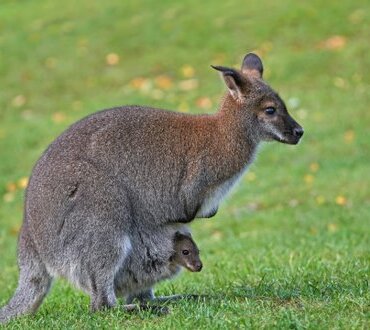
Bennett’s wallaby is found in the South Island.

Bennett’s wallaby is found in the South Island.
Australian marsupials introduced in acts of extraordinary folly are headlined by the brushtail possum.
After they were released in 1837 to create a fur trade, their numbers peaked at around 70 million. They have fallen to an estimated 30 million as a result of pest control.
Wallabies, introduced about 50 years later in the late 1800s, also with a view to establishing an industry for their skin and sport, are also an expensive unwanted addition.
Several species were introduced to Kawau Island and one each on the North and South Island.
Today their numbers are counted in the tens of thousands. Bennet’s wallabies are mostly found in South Canterbury and the Dama wallaby in the Rotorua Lakes area.
Removing them is no easy task.
On Kawau Island, where Governor George Gray introduced them in 1870 along with other exotic species, controlling them has been a major task – pest control work has been continuing with limited success on the 2020ha island since 1923.
Ironically, the Parma wallaby introduced to Kawau Island was for some time thought to be extinct in Australia and in 1967 the eradication programme stopped so that they could be caught and repatriated. It later transpired enclaves of Parma were still to be found in Australia.
But the offspring of the Kawau Island population are smaller than their Australian bred relatives, and it is thought to be a consequence of the limited food resources on Kawau.
Also in 1870, several Bennetts wallabies were imported from Tasmania to Christchurch and bred. Four years later the breeding unit provided animals which were liberated in the eastern Hunter Hills near Warmate.
The message that the animals were not suited to New Zealand did not get home. Dama wallabies were released in 1912 near Lake Ōkāreka – a few minutes’ drive from Rotorua.
“We have a real concerted effort underway in partnership with regional councils, the Department of Conservation, manawhenua, industry groups and landowners to try to contain existing wallaby populations, because left unchecked, they could cover a third of the country over the next 50 years,” Biosecurity New Zealand’s director of readiness and response, John Walsh said.
Bennett’s wallabies dominate South Island numbers and Dama wallaby dominate the north.
It is estimated damage caused by wallabies will costs $84 million a year in lost farm production and ecosystem services by 2025.
“We can’t afford to let wallaby populations spread further,” says John Walsh.
Holidaymakers out tramping and camping this summer are being urged to keep an eye out for signs of the pest.

The predicted spread of Dama wallabies in the North Island.
Source: www.mpi.govt.nz
John Walsh says while wallabies are naturally elusive, hiding in bush or scrub during the day and coming out to feed at night, reported sightings of wallabies – dead, alive, paw prints, or droppings are fundamental to the success of stopping their spread.
“We have a real concerted effort underway in partnership with regional councils, the Department of Conservation, manawhenua, industry groups and landowners to try to contain existing wallaby populations, because left unchecked, they could cover a third of the country over the next 50 years,” he says.
“This partnership, the National Wallaby Eradication Programme builds on existing wallaby management work, and with $27.5 million funding over four years, it is also boosting regional employment opportunities while also delivering environmental and economic benefits.”
“Ultimately – we want the country to be wallaby-free. It’s not a quick fix, and we need to get it right,” says Mr Walsh.
He says wallabies have a huge appetite for many native seedlings, shrubs, ferns and grasses and their browsing prevents regeneration. That changes the structure of forests, reducing their ability to support native birds and other wildlife.
Wallabies have no natural predators in New Zealand and their populations have surged wildly.
Before Christmas the Greater Wellington Regional Council asked the public to look out for wallabies in Upper Hutt and Featherston after it found several Dama Wallaby corpses in the Pakuratahi Forest and near Kaitoke Regional Park.
Control efforts by local councils, landowners and organisations have been underway in Canterbury and the Bay of Plenty these regions for decades but have been stepped up through the unified National Wallaby Eradication programme.
The Dama wallaby is one of the smallest, standing up to 500mm abd weighing up to seven kilograms. They are grey-brown in colour with a paler grey underbelly. Mature animals may have a patch of reddish brown colouring at the shoulder.

Watch out for the dama wallaby.








